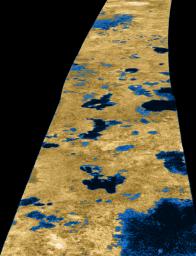No surfing on Titan
March 4th, 2010 at 1:08 pm (Planets)
 The discovery of lakes on Titan in 2006 has fueled many imaginations and also inspired a lot of questions. One of those questions was presented today at the Lunar and Planetary Science Conference (LPSC) by Ralph Lorenz. We’ve observed that these lakes are filled with liquid hydrocarbons (such as methane), so of course they are a bit different from the lakes we find on Earth. But one curiosity is that in all of our observations, we’ve never seen any evidence of waves in these lakes.
The discovery of lakes on Titan in 2006 has fueled many imaginations and also inspired a lot of questions. One of those questions was presented today at the Lunar and Planetary Science Conference (LPSC) by Ralph Lorenz. We’ve observed that these lakes are filled with liquid hydrocarbons (such as methane), so of course they are a bit different from the lakes we find on Earth. But one curiosity is that in all of our observations, we’ve never seen any evidence of waves in these lakes.
We observe lakes on Titan using radar, to penetrate through its thick atmosphere. Radar returns are sensitive to surface roughness, so waves on lakes (among other things) usually show up quite clearly. (We use this on Earth, too; see ocean features observed by Seasat.) But so far, all of our images of Titan lakes have turned out to be entirely flat and glassy: dark surfaces rather than bright ruffled ones.
Why is this? We know there are lakes and we know there are winds, so why no waves? Scientists have attacked this problem by measuring the minimum wind speed needed to kick up waves for (water) lakes on Earth (1-2 m/s) and then adjusting it for Titan’s thicker atmosphere (down to 0.5-1 m/s). Global Climate Models (GCMs) for Titan do suggest that surface winds get above this level during the local summer. Unfortunately, right now it is winter in the south, and there’s where the largest lake (Ontario Lacus) is located. Summer won’t come again until after the Cassini spacecraft’s current Equinox mission ends; the subsequent seven-year Solstice mission might have better luck.
But there could be another reason for the lack of lakes as well. Spectrographic observations of Ontario Lacus suggest that it contains not only ethane and methane but also a lot of dissolved solids (propane and others). These “tarry dregs” would likely increase the lake’s viscosity, making it even harder to ruffle.
Ultimately, until we splashdown into the lake itself, we may not know exactly why the surface stays so calm. Mission concepts such as the Titan Mare Explorer and the Titan Submersible Explorer are designed to do just that.
More info (LPSC 2-page abstracts, PDF):
- “Why Titan’s Lakes Have Been Smooth So Far — and May Be About to Get Rough,” by Lorenz, Newman, Lunine, and the Cassini RADAR Team
- “Exploring the Seas of Titan: The Titan Mare Explorer (TiME) Mission,” by Stofan, Lunine, Lorenz, Aharonson, Bierhaus, Clark, Griffith, Harri, Karkoschka, Kirk, Kantsiper, Mahaffy, Newman, Ravine, Trainer, Waite, and Zarnecki
- “Titan Submersible Explorer —The Case for Subsurface Sampling of Titanian Lakes,” by Epplery, Waite, Brockwell, Cronenberger, Klaus, and Grayson